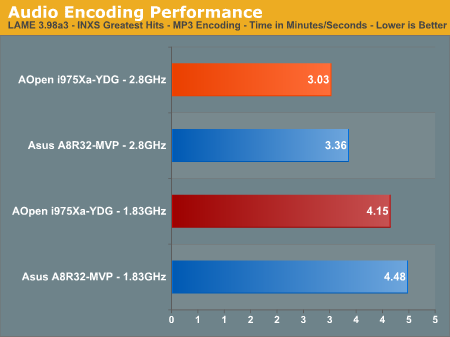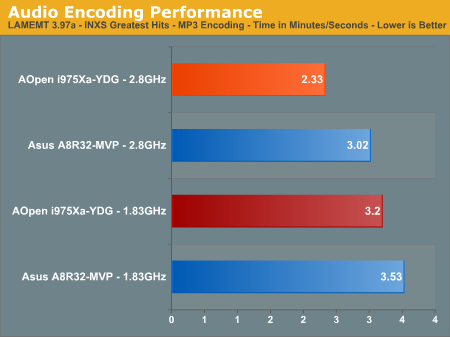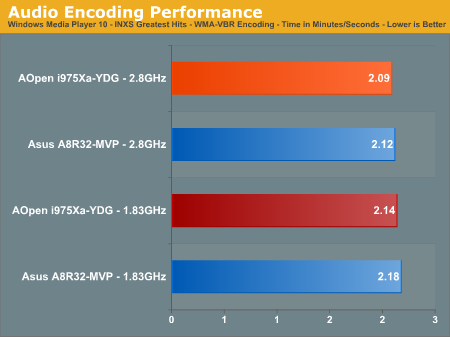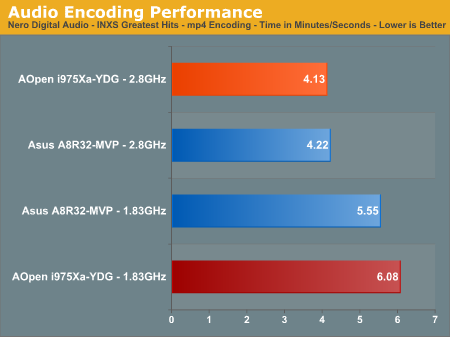Intel Core Duo: AOpen i975Xa-YDG to the Rescue
by Gary Key on May 4, 2006 8:00 AM EST- Posted in
- Motherboards
Audio Encoding Performance
While the media encoding prowess of the Intel processors has been lacking at times, they have generally faired a little better on the audio side. Our audio test suite consists of Exact Audio Copy v095.b4, LAME 3.98a3, LAME MT 3.97a-MS Compiler, Windows Media Player 10, and Nero Digital Audio.Our first task was to figure out what test CD to utilize. We needed one that contained a significant number of tracks and had over 600MB of data in order to properly stress our platforms. After rummaging around the lab and discounting the Burl Ives Greatest Christmas Hits album, we happened upon a CD that would work for our purposes as it was not working for anyone else, INXS Greatest Hits. This one time '80s glory masterpiece contains 16 tracks totaling 606MB of songs that was instantly whisked into our anxiously awaiting optical drive.
Our first test consists of utilizing Exact Audio Copy as the front end for our differing versions of LAME. We setup EAC for variable bit rate encoding, burst mode for extraction, use external program for compression, and to start the external compressor upon extraction (EAC will read the next track while LAME is working on the previous track, thus removing a potential bottleneck with the drive).
Our two versions of LAME consist of the recently released 3.98a3 and LAME MT 3.97a, which is a multi-threaded version of the LAME MP3 encoder. LAME MT was originally designed as a demonstration to show the advantages of multi-threading on the Pentium 4 with Hyper-Threading enabled. Instead of running multiple parallel threads, LAME MT generates the encoder's psycho-acoustic analysis function in a separate thread from the rest of the encoder using a simple linear pipeline and then caches it in the second thread for processing. Further details about the program and its creation can be found here. The results are presented in minutes/seconds for the encoding process, with lower numbers being better.


As in the media encoding section, the more CPU intensive operations seem to favor the Intel platform. We ran these tests several times with the results all being within one second of each other. If we shortened the test to 6 tracks then the AMD platform was within a couple of percent of the Intel platform. As we extended the size of our test samples the performance margin between the two platforms lengthened from a 2% advantage for the Intel platform to almost 11%. It concerned us to the point that we changed our drive image and then our board. We were rewarded with the same results. Running this same test on our 945GM based board resulted in a performance difference around 4% in favor of the Intel platform.
When utilizing LAME MT we see upwards of a 29% improvement in encoding times resulting in scores near that of our overclocked results. This once again shows the advantages programs can gain when they're written to take advantage of multiple-core processors or platforms.
Our next test consists of utilizing the INXS Greatest Hits CD and ripping all 16 tracks with Windows Media Player 10. We set WMP10 to rip the tracks in Widows Media Audio variable bit rate format and moved the slider all the way to the right resulting in a Best Quality request.

The results are very close for both platforms and the only comment here is that a fast optical drive is probably more important than your choice of CPU in this benchmark.
Our last audio test - and we are sure our INXS Greatest Hits CD is ecstatic about this - utilizes Nero Digital Audio to extract all 16 tracks and convert them into an mp4 format. We changed the default quality settings to transcoder-ultra, variable bit rate, encoder quality to high, and the AAC profile to LC. We were determined to give our platforms a workout with this test.

These results invoked the burning of the midnight oil along with some late night phone calls to Nero. In the end, after numerous retests and a run to Best Buy to purchase another copy of the INXS Greatest Hits CD - just to make sure CD scratches weren't causing problems - we have a situation where the AMD platform has a clear advantage at the stock settings in a program that heavily stresses the CPU subsystem. However, the Intel platform shines at the overclocked settings resulting in scores that do not follow any previous patterns in our test results.
We ran these tests over a dozen times with the same results. We noticed that on the last four tracks the Intel system would encode these files quicker than the AMD system, even though the track speed of our optical drive did not change. We thought perhaps our Opteron system was encountering some form of thermal throttling, but our temperature readings showed very little change, and adding active cooling to our OCZ memory still generated the same results.










81 Comments
View All Comments
Myrandex - Thursday, May 4, 2006 - link
Believe it or not, people can run 64bit apps for other reaons from 4GB memory...such as increased performance? I knwo not many apps right now show increased perofrmance with 64bit mode, but some do and I believe this will go up when more developers start programing for it with more intensity and all that.Jason
peternelson - Thursday, May 4, 2006 - link
For me this is the showstopper, and the reason I much prefer Turion at present.Core Solo/ Core Duo are 32 bit only. That makes them quite rarely disadvantaged - even the new Celerons can do 64 bit EM64T.
This board would be of much more interest if the review said "THIS BOARD IS MEROM-READY". As it doesn't, I assume it isn't. The review here might have highlighted this important issue which will be crucial deciding factor for some potential purchasers, especially considering the price.
I see Conroe and Merom systems quickly filling the market need this board is targetted at.
Gary Key - Friday, May 5, 2006 - link
Only disadvantaged for those utilizing 64-bit applications and operation systems, but for 95% of the marketplace they are fine. Not that I do not think it is an issue, but one that is way overblown in today's marketplace.
Probably in a couple of years it will be completely different but for now, 32-bit applications are still king of the hill (market share wise). This upsets me as I have to believe the entire migration path should have been completed by next year but the foot dragging between Microsoft and Intel negated AMD's advantage in this area for far too long. With that said, Merom takes care of the Yonah 64-bit issue in the mobile sector for Intel in a couple of months. It will be very interesting to see how it compares to Turion 64 X2, it will be good for all of us to have choices in the mobile sector.
We cannot quote on whether this board is Merom approved or not until qualification testing is complete. Will a Merom T7400 work in this board with the bios 1.3b, yes it will, and the initial results show a great deal of improvement over Yonah in certain benchmarks. Will Merom be fully supported by Intel and AOpen on this board, we do not know yet. AOpen is waiting a production spin of Merom before trying to the qualify it on this board and even then Intel might force everyone to Crestline for official support. We are still trying to figure out if Merom is going to work with 945GM as stated a couple of months ago. The entire situation is so up in the air right now that any statement has the potential to be wrong so being quiet is the best possible option. :)
johnsonx - Thursday, May 4, 2006 - link
from the spring idf article on AT:Now that may not be a 100% promise, but until Merom is actually released, there's no way to be 100% certain any given board will work with it.
Viditor - Thursday, May 4, 2006 - link
You mean 4GB or greater...at 4GB, a 32bit processor will be using PAE already.
And yes, I find that 4GB is a great help on a number of my apps...
Questar - Thursday, May 4, 2006 - link
Mobile/SFF apps?Name them.
Viditor - Thursday, May 4, 2006 - link
Photoshop CS2, Premiere Pro, and Mental Ray...
Questar - Thursday, May 4, 2006 - link
I'm a heavy Premiere user, and I can tell you it's a 32 bit app.Chadder007 - Thursday, May 4, 2006 - link
You can still run it under a 64 bit OS and have access to the 4gb or greater amount of ram.defter - Thursday, May 4, 2006 - link
No you can't. If you have an 32bit software then it can only address 4GB of memory.